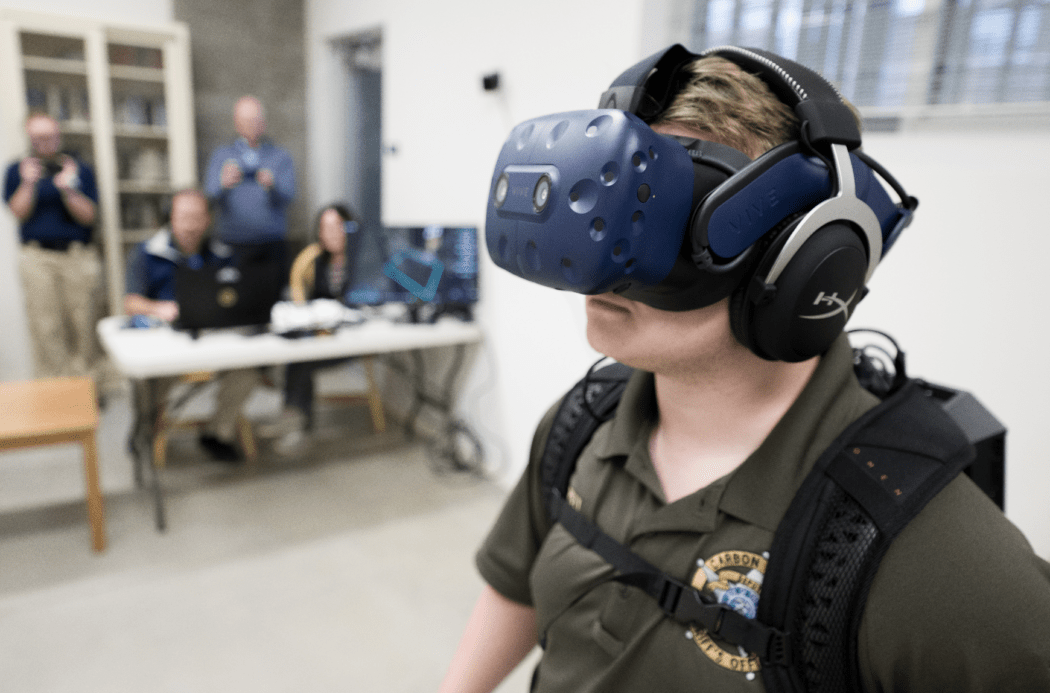USU Eastern VR technology improves, provides realistic training
The Utah State University Eastern Police Officer Academy has revolutionized police cadet training from videotapes on a projector screen to a fully immersive virtual reality simulation, and the improvements keep coming.
The VR training simulator was created by Apex Officer, a company leading in the production of new technology for police training. It was first established at the USU-E police academy in 2020 through the efforts of Scott Henrie.
Scott Henrie, the founder of the academy and former program director, wanted to step out of the box and enhance the current police training methods in a modern way.
“We are the only academy in the state that has virtual reality training,” Henrie said. “It’s the same training they’re getting, they’re just getting more of it.”
The most modern forms of police training pre-VR technology included a system called VirTra, where cadets would stand in the center of 300-degree screens and simulate themselves in the scene. The new VR technology allows for complete integration into training situations and offers users total freedom to move and interact with the scene as they wish.
“You are no longer confined to that little platform in the center of those 300-degree screens,” Henrie said. “Now you are right in the scene itself.”
The system at USU Eastern has been updated to include a second laptop, giving instructors the control of multiple virtual individuals in the scene with the ability to directly interact with the user.
“They are truly a lot more authentic and life-like,” Henrie said.
Shawn Addley is the new director of the police academy at USU-E and has witnessed the impacts the VR system has had on campus.
“Cadets have mixed reactions prior to using VR and once they do the scenarios in the VR headset, they all have nothing but positive feedback on VR,” Addley wrote in an email to The Utah Statesman.
Not only do students like the realistic feel of the VR system, it gives them greater opportunities to work on and perfect dissipating a variety of different dangerous situations. Some of the scenarios include traffic stops, active shooters, domestic violence, hostage situations and more.
“We can set up the scenario in a matter of seconds, compared to nearly 30 minutes to set up a scenario using actors, instructors, and time constraints,” Addley wrote.
According to Addley, the VR technology is updated every month with new scenarios and increased realism.
In efforts to further expand the scope of VR training scenarios, USU-E has recently purchased a VR driving simulator to help give cadets experience with operating a police vehicle.
“Once our driving simulator is on campus, we will continue to provide both VR technologies to all agencies within the state of Utah,” Addley wrote. “The driving simulator can also be provided to schools to show the dangers of texting and driving, and distracted driving.”
The police academy works with the USU-E drone program to train cadets with a form of VR technology becoming more utilized by law enforcement.
“I believe VR training is going to keep advancing in all aspects of public safety,” Addley wrote. “It will get to a point where the VR headsets and equipment needed will get smaller, more portable, and environment inclusion so we can download environments, or use a specific area such as USU-E campus.”
According to the Apex Officer website, it is their mission to consistently improve and adapt their VR technology in order to prepare a new generation of officers with the experience needed to work in a 21st century world of crime.

